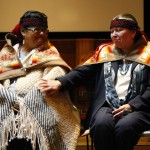Rob Capriccioso, Indian Country Today Media Network
This story was originally published on Presidents’ Day 2012.
It’s not easy drawing up a list of the best American presidents on Indian issues when it is the very government that these presidents have led that has committed so many injustices toward the Native population. Still, some presidents have gone against the fray, sometimes in surprising ways, leading on Indian issues when they could have ignored them. These are our nods on this Presidents’ Day 2012:
Richard M. Nixon: He’s the president who’s not usually on anyone’s best list, but for Indian country, he was a champion. Changing course on many of the policies that had driven so many Indians into bleak poverty, Nixon, with the guidance of his Mohawk Indian affairs leader Louis R. Bruce, endorsed a self-determination plan for tribes, ushering in a new era for Natives. “Self-determination. … without the threat of eventual termination,” is how he described the plan to Congress, asking them to repeal the 1953 House Concurrent Resolution which had endorsed Native integration. He effectively ended the policy of forced termination, encouraged the growth of tribal governments, and pledged to honor the federal government’s obligations to tribes. Soon, many laws passed Congress building on Nixon’s plan, chief among them the 1975 Indian Self-Determination and Educational Assistance Act—a major beacon of change that saw tribes begin to be in charge of their own economies. By the time that act became law, Nixon had resigned in disgrace for the bad deeds he had committed while in office. Indians, meanwhile, had a different reason to remember him.
Barack Obama: It’s taken this “One Who Helps People Throughout the Land” – his adopted Crow name – just three years to show that he’s seriously committed to taking action on Indian issues, brokering passage of the Indian Health Care Improvement Act reauthorization, the Tribal Law and Order Act, and the $3.4 billion Cobell settlement. He’s institutionalized an annual White House Tribal Nations summit, while hiring several Indians to posts throughout his administration. One niggling detail casts a shadow on all the good deeds he’s done: Indians continue to wait for a bold Obama plan that will not just atone for the sins of the past, but will help usher in the next bright era. If he is willing to institutionalize some real federal change on Indian policy, the shadow will lift.
Franklin D. Roosevelt: His New Deal will never be forgotten. For Natives, it included the Indian Reorganization Act of 1934, which ended the sale of tribal lands and restored ownership of unallocated lands to Native American groups. The policy helped reverse the Dawes Act’s infamous privatization of communal holdings of tribes, while returning to tribal self-governance. Congress ultimately altered the original intention of the policy by reducing elements of tribal self-governance and preserving federal Bureau of Indian Affairs oversight, which has led to many of the bureaucratic problems involving Indians land, royalties, and power that exist today.
Bill Clinton: He set a model for Obama, hiring Natives to work in his administration, and holding meetings with tribal leaders at the White House—both areas that the current president has taken the ball and run with. And he made some memorable commitments. His executive order on tribal consultation was a major move toward strengthening the government-to-government relationship that was supposed to always be there between the U.S. and tribal nations. His apology to Native Hawaiians showed his willingness to admit what was wrong, not worrying whether this might make him look weak. On the contrary, it made him look strong. Many Indians of the 49 other states continue to wait for their own apology from another strong president.
Ulysses S. Grant: This blast from the presidential past reminds us that good intentions were sometimes present in American history toward Indians—but that good federal intentions were and are not always the best for tribal interests. In his first inaugural address, Grant called Indians “the original occupants of this land” – few leaders were giving them that credit at the time – and he said that he was committed to rethinking the country’s horrid treatment of them. Under his Peace Policy, he wanted to achieve the ultimate Kumbaya moment by moving Indians closer to white civilization by housing them on reservations and encouraging them to farm. In hindsight, all this relocation was not only bad policy, it was bad for the Indian body and soul. Still, Grant remains interesting because he tried something other than conquering—which can’t be said of many of his historical peers. Worth noting: George H.W. Bush: When he signed the Native American Graves Protection and Repatriation Act into law in 1990, it was a pretty progressive move, especially when compared to his son who would later leave most things Indian alone. He also designated the first national Native American heritage month, and proclaimed 1992 the “Year of the American Indian.” It has since come to light that when he served as United Nations ambassador before becoming POTUS, he encouraged the spending of U.S. money to sterilize low-income women, including some Native Americans. John F. Kennedy: JFK and his brothers, Bobby and Teddy, are remembered fondly by many Natives due to their push for Indian education initiatives, as well as Bobby’s campaign visit to Pine Ridge Reservation in 1968 just before his assassination. Kennedy’s brothers were really the ones making waves, but he tends to get lumped in with them as having been a supporter. Jimmy Carter: He signed the American Indian Religious Freedom Act into law in 1979, saying, “It is a fundamental right of every American, as guaranteed by the first amendment of the Constitution, to worship as he or she pleases.” The law has led to greater support for and awareness of sacred site protection.
Read more at http://indiancountrytodaymedianetwork.com/article/this-presidents-day-we-highlight-the-best-presidents-for-indian-country-98923


















